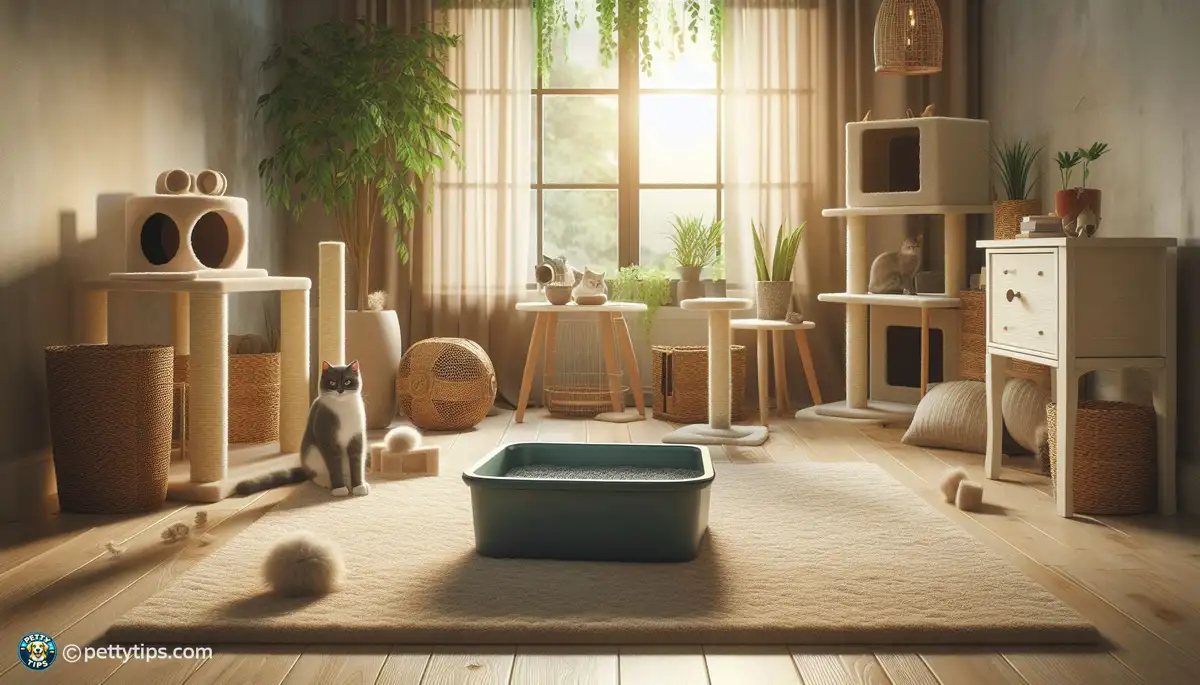- Home
- Cat Behavior
- Implementing Environmental Enrichment for Litter Box Issues
Implementing Environmental Enrichment for Litter Box Issues

The Importance of Environmental Enrichment for Cats
Enhancing Cats' Living Spaces
Cats are fascinating creatures, with instincts deeply rooted in their ancestral behaviors. When we invite them into our homes, it's crucial to understand and respect these instincts. One of the primary instincts of a cat is to explore its environment. In the wild, they would roam large territories, hunting, climbing, and exploring. However, in our homes, their territory is often limited to a few rooms. This confinement can lead to boredom and frustration if their environment lacks stimulation.
Stimulating Their Senses
environmental enrichment is all about providing cats with opportunities to engage their natural behaviors in a domestic setting. By enriching their environment, we can stimulate their senses, keep them mentally and physically active, and prevent behavioral problems like litter box issues. Cats have highly developed senses of smell, sight, and hearing, and they thrive in environments that allow them to use these senses to their fullest.
Addressing Boredom and Stress
Boredom and stress are common triggers for litter box problems in cats. When a cat is bored, it may seek out inappropriate places to eliminate as a way to relieve its boredom or mark its territory. Similarly, stress can lead to changes in a cat's elimination habits. Environmental enrichment provides cats with mental stimulation and outlets for natural behaviors, reducing boredom and stress and ultimately preventing litter box problems.
Designing an Enriched Environment for Cats
Providing Vertical Space
Cats are natural climbers, and vertical space is essential for their physical and mental well-being. Vertical spaces such as cat trees, shelves, and window perches allow cats to climb, jump, and survey their surroundings. Providing vertical space not only enriches their environment but also gives them a sense of security and control over their territory.
Interactive Toys and Puzzle Feeders
interactive toys and puzzle feeders are excellent tools for keeping cats mentally stimulated and physically active. Toys that mimic prey behavior, such as feather wands and laser pointers, tap into cats' hunting instincts and provide hours of entertainment. Puzzle feeders require cats to work for their food, encouraging problem-solving and preventing boredom.
Rotating and Refreshing Enrichment
Cats can quickly become bored with their environment if it remains stagnant. To keep things fresh and exciting, it's essential to rotate and refresh their enrichment regularly. Introducing new toys, rearranging furniture, or adding new climbing structures can reignite their interest and prevent boredom-induced litter box problems.
Enrichment Techniques to Address Litter Box Problems
Multiple Litter Boxes in Different Locations
One common mistake cat owners make is not providing enough litter boxes or placing them in inconvenient locations. Cats prefer to have options when it comes to eliminating, and having multiple litter boxes in various locations ensures that they always have access to a clean and private space. Ideally, there should be one litter box per cat plus one extra, placed in quiet, low-traffic areas.
Litter Box Placement and Size
The placement and size of the litter box can also influence a cat's willingness to use it. Cats prefer large, uncovered litter boxes placed in quiet, easily accessible locations. Covered litter boxes can trap odors and make cats feel confined, leading to litter box aversion. It's essential to choose a litter box that is large enough for the cat to comfortably enter, turn around, and dig.
Litter Substrate Preferences
Cats can be picky about the type of litter they prefer. Some cats prefer clumping litter, while others prefer non-clumping or natural alternatives like sand or wood pellets. Experimenting with different types of litter can help determine your cat's preferences and prevent litter box problems. Additionally, keeping the litter clean and scooping it at least once a day is crucial for maintaining a clean and inviting litter box environment.
Conclusion: Creating a Happy and Healthy Environment for Cats
Investing in Environmental Enrichment
Investing time and effort into creating an enriched environment for your cat is one of the best ways to prevent and resolve litter box problems. By understanding your cat's natural behaviors and providing outlets for those behaviors, you can keep them mentally and physically stimulated, reduce stress and boredom, and ultimately create a happier and healthier environment for both you and your feline friend. Remember, environmental enrichment is not just a luxury for cats—it's a necessity for their well-being. So, get creative, and start enriching your cat's life today!
